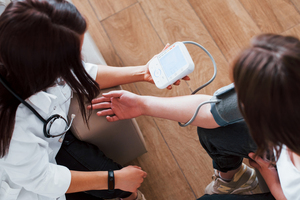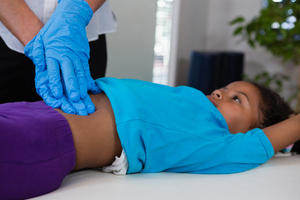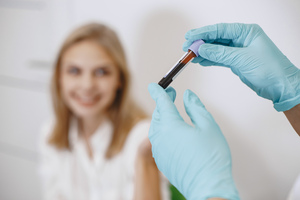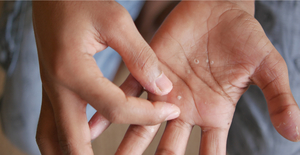Key points
- Diabetic ulcers and sores are common in people with diabetes, with a global prevalence of 6.3% and are often slow to heal.
- Slow wound healing in diabetics increases the risk of complications like infection and amputation, necessitating proper wound care.
- High blood sugar, nerve damage, and poor immunity in diabetics can cause ulcers and sores that don't heal.
- Untreated diabetic wounds can lead to serious complications, including amputation, osteomyelitis, and sepsis.
- Those with diabetes should regularly consult with their healthcare provider for proper foot care and ulcer prevention. Those suspecting they may have diabetes can use resources like Solv to find diabetes testing in their area and locate urgent care for immediate attention to diabetes wounds.
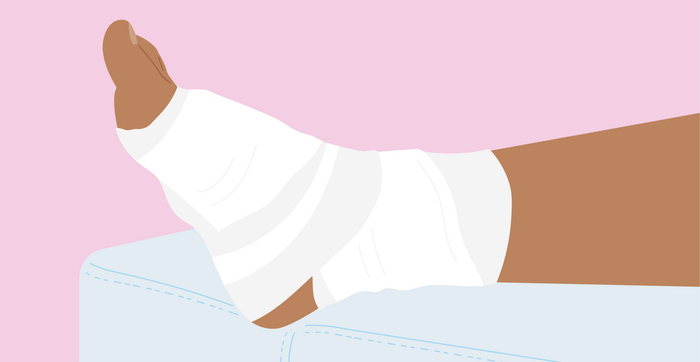
Diabetic ulcers and sores are highly common among people with diabetes and can develop anywhere on the body, though most people develop them on the feet. According to the Annals of Medicine, the global prevalence of foot ulcers among diabetics is 6.3%, with North America having the highest rate of 13%.
According to the NIH, these ulcers and sores in diabetics often take longer to heal than those that develop in people without diabetes. Slow wound healing increases the risk of complications, including infection and amputation, which is why proper wound care is essential for people with diabetes.
Continue reading to learn more about the link between diabetes and slow wound healing, and information on how to help care for a sore or ulcer if you have diabetes.
How Diabetes Affects Your Body
Diabetes is characterized by an impairment in the way your body produces or responds to insulin. This means your body may not produce enough insulin or doesn’t use insulin properly as it should.
Insulin is a hormone that allows cells to use glucose (sugar) for energy. When your body is unable to make enough insulin or move it into cells where it can be used for energy, glucose can build up in the bloodstream. This often leads to high blood sugar levels, which can damage blood vessels.
High blood sugar caused by diabetes increases the risk for a wide range of serious health problems, including heart disease, stroke, kidney disease, and many more. It can also lead to the development of a diabetic ulcer on behalf of slow wound healing.
Diabetes and Wound Healing
According to Cancer.gov, chronically high blood sugar levels caused by diabetes can impair the functioning of your white blood cells. White blood cells are part of your immune system and help fight off illness, disease, and harmful bacteria. When white blood cells become impaired, they have more difficulty helping your body heal. This often leads to slow wound healing and the development of diabetic sores and ulcers.
People with diabetes often have poor circulation due to damaged blood vessels from high blood sugar. Poor circulation in diabetics may also be caused by other diabetes risk factors such as physical inactivity and being overweight. When circulation becomes impaired, blood moves more slowly and cannot deliver nutrients to wounds to help them heal. This often leads to slow wound healing or no healing at all.
In addition to damaging blood vessels, high blood sugar may cause nerve damage, also known as diabetic neuropathy. Nerve damage can make it difficult for people with diabetes to feel wounds, which means they can develop an ulcer or sore and have no idea. This is another factor that can lead to a serious diabetes wound and related complications.
What Are Diabetic Ulcers and Diabetic Sores?
Diabetic ulcers and sores are wounds that develop in people with diabetes. They are open wounds that heal slowly or that don’t heal at all due to high blood sugar, nerve damage, and poor immunity.
The NIH indicates foot ulcers are the most common type of ulcer that affect people with diabetes, though they may also develop on your legs, hands, or on the skin in the fold of your stomach.
Diabetes sores on the feet may occur if you wear low-quality or poorly fitting shoes or if you do not trim your toenails regularly. Moisture on the feet can also lead to a diabetic ulcer, such as continuing to wear the same socks and shoes after a sweaty workout or failing to fully dry your feet after a bath or shower. Diabetic sores and ulcers may also develop if you step on debris like a nail or splinter and are unable to feel the wound due to nerve damage.
How to Care for Diabetic Sores
According to the Centers for Disease Control and Prevention (CDC), a diabetic sore should be cared for right away to reduce the risk of infection. If you have diabetes, inspect your feet daily for irritation, cracks, and puncture wounds that may have been caused by a sharp object.
Contact a healthcare provider the moment you discover a diabetic sore or ulcer. They can offer treatment recommendations for the wound and also show you how to properly care for it at home.
The following tips from Medline Plus offer guidance on how to care for your wound. First, clean your ulcer daily using mild soap and water. Keep the wound covered with a dressing to accelerate the healing process. Make sure you change the dressing regularly as needed to prevent it from becoming moist and increasing bacterial growth.
Avoid putting any pressure on the wound, especially if the sore is on your foot. Use crutches or a foot brace if necessary, or relax and stay off your feet. Putting pressure on the ulcer can further damage the skin to cause a deeper wound that takes even longer to heal.
Your healthcare provider may also recommend taking extra care to manage your blood sugar level. Controlling your blood sugar and avoiding any spikes may help your diabetic ulcer heal more quickly and efficiently.
What Can Happen if Diabetic Wounds Are Left Untreated?
Amputation is the most serious potential complication of untreated diabetic wounds. Data from the CDC shows that the rate of toe and foot amputation among diabetics increased by 62% between 2009 and 2015. Furthermore, data from the Administration for Community Living (ACL) indicates amputations performed above or just below the knee increased by 29% during this same period. Amputations in diabetics are usually caused by gangrene, which is the death of body tissue due to bacterial infection in the wound or lack of blood flow to the wound.
According to the CDC, osteomyelitis and sepsis are other potential complications of untreated diabetic wounds. Osteomyelitis is a type of infection that occurs when an untreated infected ulcer spreads to nearby bone. Sepsis is a life-threatening complication that can occur when an uncontrolled infection spreads into the bloodstream and begins causing organ dysfunction.
Don’t hesitate to reach out to your doctor if you have diabetes. Your doctor can show you how to properly care for your feet and any ulcers you develop and talk to you in greater detail about how to prevent a diabetes wound.
If you think you may have diabetes, use Solv to find diabetes testing in your area. Solv can connect you with high-quality healthcare providers that perform a same-day diabetes test. If you have a diabetes wound that requires immediate attention, Solv can also help you locate the nearest urgent care or walk-in clinic that provides diabetes wound care.
FAQs
Why are diabetic ulcers and sores slow to heal?
The slow healing of wounds in diabetics is due to high blood sugar levels, nerve damage, and impaired immunity, which affect the body's healing process.
What are the risks associated with slow wound healing in diabetics?
Slow wound healing in diabetics can lead to complications like infection and amputation due to the increased risk of bacterial growth in the wound.
How can diabetics care for their ulcers and sores?
Diabetics should clean their wounds daily, keep them covered with a dressing, avoid putting pressure on the wound, and manage their blood sugar levels.
What are the potential complications of untreated diabetic wounds?
Untreated diabetic wounds can lead to serious complications like amputation, osteomyelitis (bone infection), and sepsis (blood infection).
What is the prevalence of foot ulcers among diabetics?
The global prevalence of foot ulcers among diabetics is 6.3%, with North America having the highest rate of 13%.
What is the global prevalence of foot ulcers among diabetics?
According to the Annals of Medicine, the global prevalence of foot ulcers among diabetics is 6.3%, with North America having the highest rate of 13%.
How does diabetes affect the body?
Diabetes is characterized by an impairment in the way your body produces or responds to insulin. This can result in high blood sugar levels, which can damage blood vessels and increase the risk for a wide range of serious health problems, including heart disease, stroke, kidney disease, and the development of diabetic ulcers.
How can I prevent diabetic sores and ulcers?
Preventing diabetic sores and ulcers involves regular foot inspections for irritation, cracks, and puncture wounds. It's also important to wear high-quality, well-fitting shoes, trim your toenails regularly, keep your feet dry, and avoid


